The Solution
Relocalize
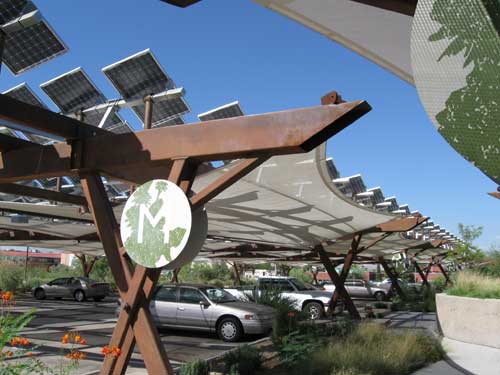
^Photovoltaic array over a parking lot in the middle of a city.
Continued from page 1, The Solution...
Relocalization is a term for a way of life, where not only energy is locally produced and consumed, but also food and goods. The idea is to strengthen the local economy rather than ship everything in from across the country and overseas.
Much of the conventional thinking about alternative energy rallied around mega projects: 60 square miles filled with huge arrays of solar collectors that produce enough energy to power a small city. But 8 to 12% of the electricity generated at these remote sources is lost along the wires, largely from resistance, before the energy reaches the city. And corporate control of pricing is still a problem as it is in today's energy distribution grid.
Jason Bradford, Ph.D., founder of the nonprofit Willits Economic Localization (WELL) in Willits, California, foresees a sutainable local economy for towns like his: “There needs to be local infrastructure for local use. There need to be micro and regional grids.”

^Rooftop photovoltaic panels on top of a wharehouse in Richmond, next to the freeway in the heart of the bustling Bay Area metropolis.
Julian Darley, founder of the Post Carbon Institute in Sebastopol, Caliornia, says, “The emphasis should be on the community level”. Communities could have solar panels on home rooftops but also on factory roofs, as WalMart and REI are starting to do in certain areas. Excess power produced from these panels then flows back into a local grid, rather than a statewide or multistate grid. Darley envisions photovoltaic community gardens instead of PV factory farms. This would minimize distribution losses.
Smallscale wind power also fits into this picture, microturbines designed to generate wind power within or close to communities where people live, rather than on remote thousand-acre wind-farms with huge, horizontal-axis turbines remote from users.
Local energy advocate Sheila Bowers put it well: "The internet is actually magnificent and successful because it is WHOLLY DECENTRALIZED, with computers in every home and millions of servers all over the place. It is a common comment that 'the internet never could have worked if they tried to do it with 5 or 6 giant mainframes.'...LOCAL, POINT OF USE, DECENTRALIZED, DISTRIBUTED solutions are comparable to the genius and reliability of the Internet, and the PC and cellphone revolutions were based on PUBLIC ENGAGEMENT AT THE CONSUMER LEVEL, which is what led to rapid increases in efficiency and drops in price."
In a similar way, strategies about regenerating the "commons" and self-organizing partnerships to locally manage these "common goods" such as resources and energy are taking shape.
Go Rooftop! Microgeneration
30 billion square feet of commercial rooftop surface is available for photovoltaic systems in the US which could create in excess of 150 gigawatts of electricity (that's 150 billion watts).
Just think of it: if we could cover the 30 billion square feet of available commercial rooftop (not even including private home roofs) with PV, that would be the equivalent of building 100 coal-burning or nuclear power plants. Or this could save more than 1 million acres of desert from being scraped and bulldozed for solar thermal power plants, which is the amount of land they need to produce an equivalence in wattage!
Micro Power-grids in Parks

^Photovoltaic panels next to the parking lot of the Death Valley National Park visitir center.
Right next to the Amargosa Desert, the National Park Service and their concession company, Xanterra, have placed photovoltaic panel arrays to gather up the abundant sun in Death Valley National Park, California.
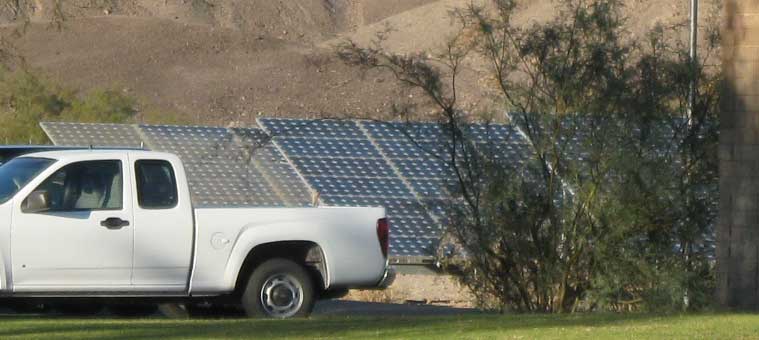
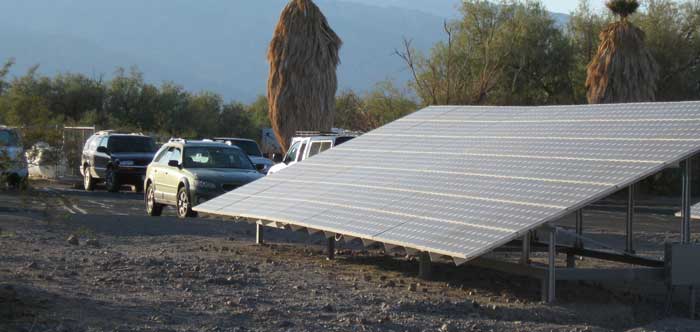
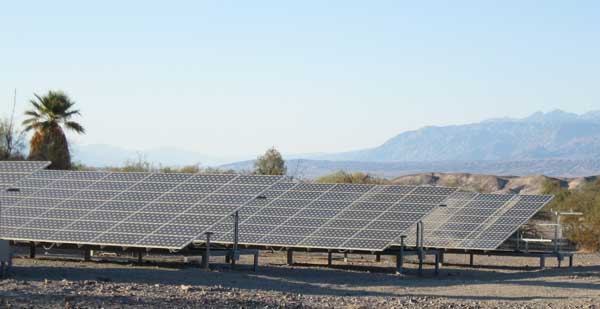
^A local solar panel array next to a building saves our open land from distant mega-sized solar farms out of our control.
Xanterra, the company running the tourism services in Death Valley National Park, in 2008 built a 1 megawatt photovoltaic array right in the middle of its Furnace Creek Ranch land, next to motels, restaurants, and the famous lowest-elevation golf course. The array was built in a date orchard, and many of the date palms were relocated to adjacent spots. The 4 acre array consists of 5,740 panels and will generate a third of the entire tourist town's electricity each year.

^Four-acre photovoltaic farm replaces part of an unused orchard in Furnace Creek Ranch.
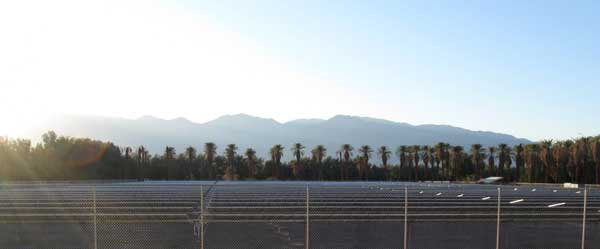
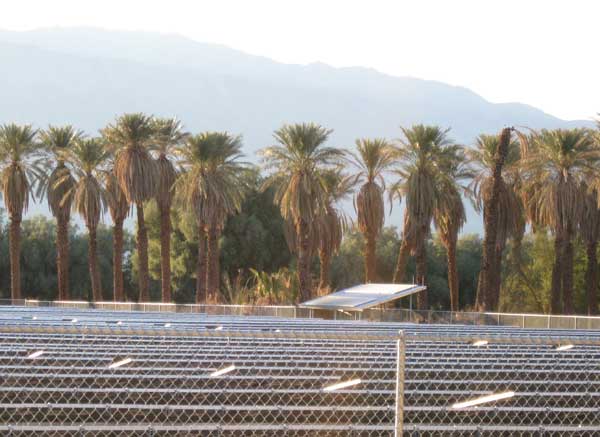
University Power
The University of California at San Diego now generates 80% of its own electricity, through the work of Byron Washom, the first director of strategic energy initiatives. Since 2008 he turned the 1,200-acre campus into a model of sustainability using renewable energy, energy management, greenhouse-gas reduction, energy storage systems and greening the campus transportation fleet. The university generates 80% of its own electricity.
(See article in the Los Angeles Times >>here)
City Power
Meanwhile people in the cities are also looking at local energy production. The Springs Preserve in Las Vegas, Nevada, two hours southeast of the Amargosa Desert, has built a nifty photovoltaic panel array over their visitor parking lot (below).
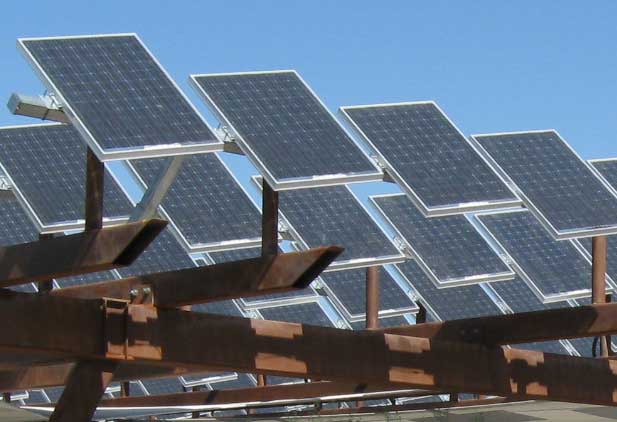
^Mini panels above the parking lot at Springs Preserve.
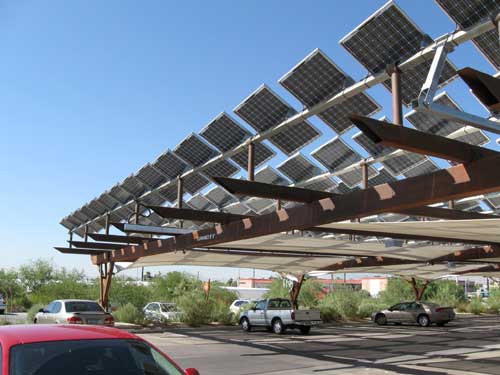

Southern California Edison plans to install 250 MW of commercial rooftop photovoltaic. With the development of new solar technologies like thin-film cadmium-telluride photovoltaic sheets, which although they have lower efficiency than thick silicon panels also are much cheaper, PV is becoming competitive with CSP. Small 10 to 20 MW PV plants can be placed next to or within cities and towns, with the huge advantage of having the ability to be interconnected with existing small 34.5kVto 115kV transmission lines, instead of requiring costly new high-voltage lines stretching for hundreds of miles (with attendant permit delays).
Solar-powered Communities
We heard about a new solar-powered subdivision in Las Vegas, Sommerset by Concordia Homes, that would have high-efficiency homes with rooftop solar that also incorporate water conservation measures (a really great idea in the Mojave Desert!). The technology is by GE ecoimagination, and the houses range in the $200,000s. Energy-hungry Las Vegas surely needs more of these, so we did a ground-check to take a closer look. Unfortunately the office seemed closed up and almost no houses were built on the dirt pads, as if Americans were not yet ready to pay extra for these efficient future-homes. The current mortgage crisis will not help, but the idea we think is good.

Canada is farther along. The Drake Landing Solar Community in Okotoks, Alberta, proves that you don't need to limit this technology to the desert. Completed in 2007, a community of 52 homes is now fully occupied by residents who enjoy heat in their -33C winters from stored summer heat. Detached garages have 800 photovoltaic panels that generate 1.5 megawatts in a day. Insulated pipes holding glycol solution become heated by the panels, and the pipes connect to "district loops" that ultimately carry the heat to underground boreholes at the center of the community. Solar heat is thus stored underground and releases back to the homes all winter, providing 90% of their heating for both room space and water. This Borehole Thermal Energy Storage technology is a fantastic example of local energy generation and usage. And it saves 5 tons of greenhouse gases per house per year from escaping into the atmosphere.
We eagerly await the day when the price of PV panels and thin-film will come down to the affordabilty of walking into a Home Depot or Lowe's and walking out with a do-it-yourself kit for our own place. As it stands now, the cost of getting a house off the grid is hefty, and for some of us the amount of the tax credit alone is more than we make in a year -- just not an option yet. We hope future President Obama and the Democratic Congress will consider helping more than just corporations in the drive for energy independence.
So let's consider better urban planning: keep the energy production in or next to the cities and towns we live in, and not scrape up pristine desert and pump massive amounts of groundwater. In our drive to mediate global warming, are we going to "save the atmosphere by killing the land?"
State Power
California has aggressive plans for making rooftop solar a part of their energy plan. Governor Arnold Schwarzenegger signed a senate bill in 2006 completing the "Million Solar Roofs Plan". Three thousand megawatts of solar energy would be provided by making solar power a standard item on new homes by 2018: developers of more than 50 new single family homes would be required to offer the option of a solar energy system to all customers beginning January 1, 2011 (why not a necessity?). "One million solar roofs will greatly increase the state’s rooftop solar energy capacity, providing the output equivalent of five modern electric power plants," says the governor's website.
The bill also made it easier for businesses and home-owners who install solar on their rooftops to sell the excess energy back to utility companies, earning money.
The California Solar Initiative provides cash back for solar for existing homes, as well as existing and new commercial, industrial, government, non-profit, and agricultural properties. A proposal has been raised for muliti-family affordable solar housing incentives. See the 2008 California Solar Initiative.
These are the kinds of ideas we believe President Obama should look at more seriously.
Country Power

^Germany's Reichstag Parliament building has a glass dome that helps illuminate the legislative chamber by needing less electric lights. In addition, most of the roof is fitted with solar panels. Biodiesel also powers the building in part. (Courtesy www.energy.gov.on.ca)
Building Integrated Photovoltaic (BIPV) installations are being used in Germany, a cloudier place than much of the US, generating renewable energy at the point of use: rooftops. In 2007 and 2008 Germany built 2,300 megawatts (MW) of locally generated and distributed renewable energy on private and corporate buildings, and even the Parliament building was retrofitted with solar panels on the roof. The country aims for 2,000 MW per year by 2012, bringing the total to 10,000 MW. The German Renewable Energy Sources Act gives priority to connect to the grid to all BIPV systems over open-land ground systems.
Feed-in Tariffs
Feed-in tariffs (FITs) are production incentives that require that utilities buy electricity generated by renewable sources at certain prices for a period of several years (20 in Germany for solar). Germany's Renewable Energy Law (Erneuerbare-Energien-Gesetz) promotes the development of renewable energy sources with a feed-in tariff scheme, and is considered a model of successful renewable energy integration. Many other countries in Europe use FITs, as well as Israel and Australia. They can help jump start a market for renewable technologies and offer investment security and market stability.
The California feed-in tariff allows eligible customer-generators to enter into 10-, 15- or 20-year standard contracts with their utilities to sell the electricity produced by small renewable energy systems -- up to 1.5 MW -- at time-differentiated market-based prices. Hawaii is aiming to enact FITs too.
In February 2009, Gainesville, Florida approved the nation’s first solar feed-in tariff ordinance. Residents with photovoltaic panels on their roofs will recieve 32 cents a kilowatt-hour when they produce energy. Usually homeowners in Florida pay on average 12 cents a kilowatt hour for their electricity, according to Department of Energy statistics. Gainesville Regional Utilities would buy all the energy produced by a solar photovoltaic system over the next 20 years for a guaranteed rate per kilowatt hour — the price would be set to make solar energy production competitive. The feed-in-tariff program would also make it possible for tax-exempt agencies – like the University of Florida – to benefit from an incentive by leasing out roof-top space to a solar production company.
Feed-in tariffs, which allow solar operators, both large and small, to earn a higher price for each unit of energy they produce for a grid than utilities reliant on electricity from dirtier sources like coal, help operators cover the comparatively higher cost of production of renewables. The implication is that as the government supports the renewable industry now, it will be able to match peak-hour pricing from coal and natural gas by 2012 – meaning that the industry would not need subsidies anymore. (Recall how large the tax breaks have been historically for Big Oil.)
See more: read the article "The Better Way" by Alliance for Responsible Energy Policy (AREP).
See the Guest Article "New Policies Promote 'The Better Way'" by Jim Harvey of AREP >>here.
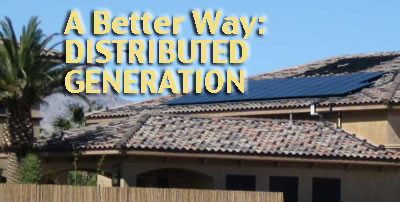
Local Government Loans
New developments in financing residential solar are coming from California, allowing cities create special tax assesment districts where homeowners can borrow money from the local jurisdiction and pay it back over time through an increase in property tax. When you sell the home, the loan stays with the house. Berkeley pioneered the approach with its Financing Initiative for Renewable and Solar Technology (FIRST), that finances up to $37,500 per installation for residential or commercial properties without a down payment and a 20-year property tax assessment. (For those wincing at a few dollars more on their property taxes, consider the future of industrial remote renewable power plants far out in the desert or mountains that must be built from scratch and the $2 million-per-mile new transmission lines that will accompany them -- these costs will be passed on to the customer by the utility companies.)
Assembly Bill 811, used successfully by Palm Desert, Berkeley and San Francisco, allows California counties and cities to sell bonds to fund “permanently fixed improvements” to private property the way they can for public works. The government would be allowed to pay off the bonds via special districts in which residents or businesses can opt for loans paid back over a period of time or through property taxes.
The Berkeley AB 811 program which began in November 2008, and all 40 slots in the pilot program were scooped up in 9 minutes. The first photovoltaic system was up and running in three months. This is incredibly fast compared to the years of slow planning and development that an industrial solar thermal plant must undergo when placed on public land.
The New Mexico Legislature is considering a similar measure sponsored by Rep. Brian Egolf (D-Santa Fe). House Bill 572 would allow counties to create solar-energy districts, where homeowners could opt into the district, find a lender and solar-energy installer and have the loan repayment tacked on to their annual property tax bill. The loans would be good for systems that generate electricity, solar hot water, or solar hot. See the story in the Santa Fe New Mexican >>here.
We recommend everyone meet with your elected representatives and push AB 811 funding for every town and county in California, and push for similar legislation in other states.
Power Purchase Agreements
In PPAs the provider finances, installs, owns, and operates the renewable energy system on your property so you have no capital investment up front. You are billed for the actual electrical output by the PPA provider, often at a discounted price. No need to bill the customer for all those new expensive transmission lines.
Showing that cities can generate their own power without relying on massive new solar or wind developments a thousand miles away, Silicon Valley's San Jose Unified School District in California total of 5.5 MW of solar power at 14 district sites. Chevron Energy Solutions designed, built, and operates the photovoltaic arrays for the district. Bank of America, through the Bank of America Public Capital Corporation Energy Services team, owns the solar equipment and sells power to the district under a service contract at set rates significantly below market utility rates, providing the schools savings and energy cost predictability. The district expects its energy costs to be reduced by more than 30% and to save its general fund more than $25 million over the 25-year life of the project. The California Solar Initiative and other incentives offset the overall cost of the program by more than $11 million. If the district were to finance the project itself, it would borrow $18.1 million for the first phase, and end up paying much more than $30 million, including interest.
The program is also combining high efficiency and conservation programs, replacing old equipment to save energy.
See the story >>here.

The city of Freiberg, Germany, has a distributed electricity network where PV panels on roofs feed energy back into the main grid. Above is a passive energy neighborhood. (Courtesy www.energy.gov.on.ca)
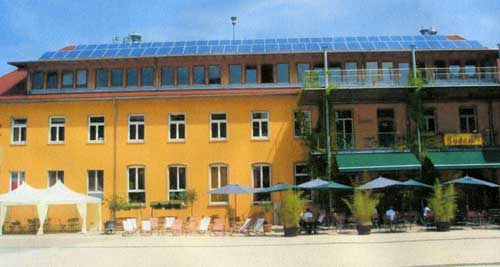
Community center with solar-power roof. (Courtesy www.energy.gov.on.ca)
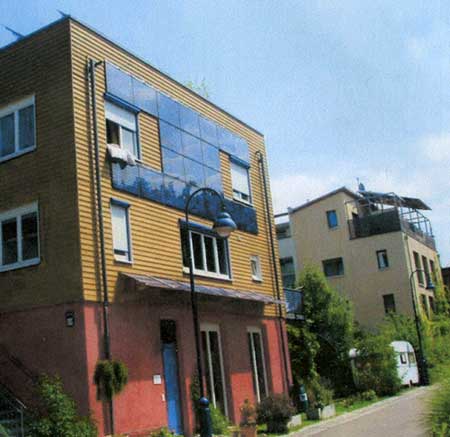
Energy efficient neighborhood. (Courtesy www.energy.gov.on.ca)
Energy Efficiency and Conservation
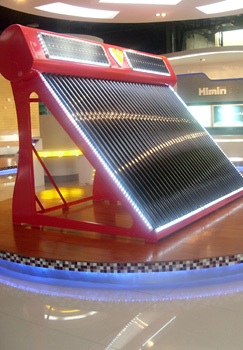 China is ahead of the U.S. in saving energy and coming up with innovative ways to integrate local energy-saving technology into buildings. Millions of solar thermal water heaters with rows of chrome-coated tubes are manufactured by Himin Solar Energy Group in China each year for use on rooftops. Their corporate building alone saves 1 million kilowatt-hours by using solar heating. About one in every 10 Chinese households uses a solar thermal water heater, sourcing one of the biggest uses of electricity with clean energy. Mandatory energy efficiency standards for electronics and home appliances went into effect about four years ago.
China is ahead of the U.S. in saving energy and coming up with innovative ways to integrate local energy-saving technology into buildings. Millions of solar thermal water heaters with rows of chrome-coated tubes are manufactured by Himin Solar Energy Group in China each year for use on rooftops. Their corporate building alone saves 1 million kilowatt-hours by using solar heating. About one in every 10 Chinese households uses a solar thermal water heater, sourcing one of the biggest uses of electricity with clean energy. Mandatory energy efficiency standards for electronics and home appliances went into effect about four years ago.
The Shenzhen LianChuang Energy Conservation Equipment Co. displays light-emitting diode (LED) lighting that can save 40 to 60 percent of electricity. They also have mechanisms that adjust the voltage of factory machine tools and other power equipment, saving both watts and dollars for their clients.
^Chinese solar water heater, and on rooftop, below.
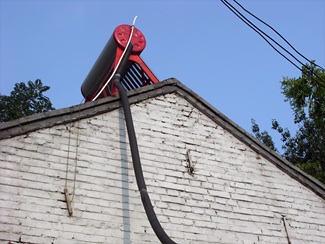
According to the National Development and Reform Commission, China's energy intensity decreased by about 10 percent between 2006 and 2008.
(Source: http://www.eenews.net/climatewire/2009/10/06/)
"Energy efficiency savings are what really provide the net benefit," said nonprofit U.N. Foundation official Glenn Prickett.
October 7, 2009: Britain's opposition Conservative Party will guarantee every homeowner an allowance of up to £6,500 ($10,356) for improved energy efficiency if the party wins Britain's next round of elections, from private and charity funds.
(Source: http://www.eenews.net/climatewire/2009/10/07/)
Contact President Obama
You may copy and paste the paragraph below to the comment section of President Obama's White House website (or make your own comments):
Check out the new administration's energy plan:
www.whitehouse.gov/agenda/energy_and_environment/
While I support alternative energy, I support it on roof tops and in disturbed areas. Most proposed solar facilities on public lands are the wet-cooled parabolic solar mirror trough systems. These require over 5 acre feet of water per megawatt. This will dry up springs and destroy ground water resources that wildlife depends on. The desert is not a wasteland. It supports a variety of unique plants and animals. Solar developments require complete scraping of vegetation. Vegetation and organic soils in the desert store carbon better than most ecosystems. Scraping it up for solar power plants will result in more carbon being released into the atmosphere. Placing unsightly developments and powerlines all over the desert will disrupt the lives of thousands of rural people who will have their property values decline. Many will face the threat of eminent domain because their property lies in the path of powerlines. Please support alternative energy in a GREEN fashion that uses roof tops, canopies over parking lots, and vacant lots in urban areas. Please give tax incentives to retail stores to encourage them to sell photovoltaic panels for home use at affordable prices. Please do not sacrifice the last of our public lands to benefit only large energy corporations. Thank you.

^View looking south from the Greenwater Range, west side of the Amargosa Desert. We can keep our open lands open, and localize our power in the cities and towns.

^Calico cactus (Echinocereus engelmannii), Amargosa Desert.
